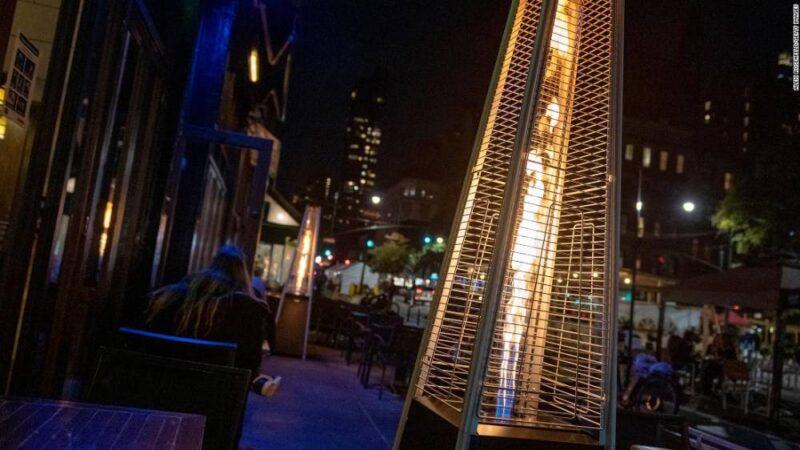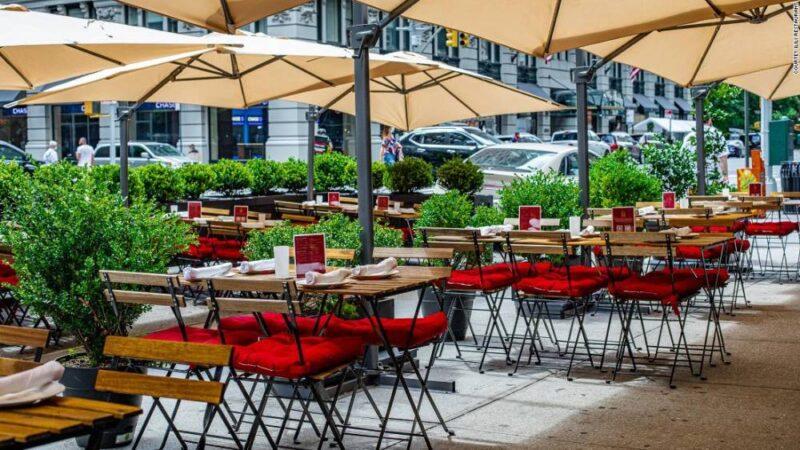New York (CNN Business)Over the summer, diners flocked to hastily assembled outdoor patios. The airy option was great for people still wary of eating indoors because of the coronavirus pandemic and offered a much-needed sales boost for restaurants with dining restrictions.
But now that the weather is turning in parts of the country, that option is becoming less appealing. For a window into how it’s going for some restaurant owners, look at New York City, once the epicenter of the coronavirus. The city’s nearly $27 billion restaurant industry nearly ground to a halt in the spring. Now, NYC has one of the country’s most stringent capacity limits, 25%, for indoor dining. The combination of tough restrictions and brutal winters are forcing restaurant operators to do the difficult math of how much to spend to make outdoor seating warm enough to attract patrons without going out of business.

A heater near outdoor tables at Tenzan restaurant on October 18, 2020 in New York City.For some, outdoor heating may be too expensive altogether, making for a bleak winter ahead.Jeremy Wladis, president of the Restaurant Group, which operates Good Enough to Eat, Harvest Kitchen and other New York City restaurants, saw a frightening preview of the months ahead during a few rainy, chilly days in October. Read More”Our sales just dropped like a rock,” he said. “And we were not able to pay our bills before. A good day is when you hit 50% of your sales from prior to Covid. On a day like this you do five or 10% of your sales.”Wladis purchased a number of electric heaters earlier this fall. They didn’t work very well for him, so he recently ordered another round of electric infrared heaters that he thinks will be better and is in the process of returning the first set. He’s still dubious of how much of a difference they’ll make. “On a 35 degree day, if you’re lucky you’re warming it up 45-50 degrees. I don’t think a lot of people are going to eat” under those conditions, he said. “And when it’s really cold, there’s no shot.” Juliet and Justine Masters, who operate The Edge Harlem, a restaurant that serves Jamaican, English and American foods, are still deciding whether to install outdoor heaters. They only have a handful of tables set up outside their restaurant and wonder whether they’ll be able to recoup the investment on such a small space.

The Edge’s outdoor seating setup.”Any situation that we troubleshoot in order to get more seats available to our customers is going to be expensive,” Justine said. “We’re just trying to break even.” Some restaurant operators who were hoping to make outdoor seating work are finding that it might not. Philippe Massoud, CEO of the Lebanese restaurant ilili, purchased propane heaters before the city released guidance on outdoor heating. Now, because of recently released rules, he doesn’t think he’ll be able to use them.”It’s almost impossible,” he said. In order to use the heaters he purchased, he’d need to pay for a service to pick them up and return them every day — an option that may be too expensive. Restaurants can also use natural gas to heat outdoor spaces but need several rounds of approval from the city to set those types of heaters up.Massoud is planning to return the propane heaters. But he said that it doesn’t make sense to replace them with electric ones. “These heaters require an exorbitant amount of power,” he said.Massoud calculated that in order to keep his outdoor space comfortable, he’d need to spend $16,000 on electric heaters and another $16,000 on new electrical panels. Then there’s the actual electrical bill, which would be “through the roof.” To justify that type of investment, he said, he’d need roughly 384 customers a week through the winter.

ilili’s outdoor seating.The question, he said, then becomes “are there [enough] New Yorkers that are going to come and sit out there in the elements?” For now, he’s betting no. “I haven’t found a way to justify the costs and make it make sense as of yet based on the amount of days that we can use it and make it comfortable,” he said. He’s still exploring options. Some restaurant operators are calling for the city to double its 25% cap on indoor dining. But others don’t want to rely on it as the pandemic rages on, and spikes in cases could mean a return to a full ban. “I don’t want to shift our business model to interior dining, and then it doesn’t go to 50%,” said Lauren Lynch, co-owner of the bar-restaurant Harlem Public. Plus, Lynch said, she’s worried about what might happen if the city loosens restrictions too much.
“I don’t want to be back to the point where we’re hearing ambulances going by all day long,” she said. “It was traumatic.” A better solution, Lynch said, would be rent relief or more government support, like the paycheck protection programs that helped bail businesses out this spring. Without that type of financial support, restaurants will “hang on as long as they can,” she said. “But they’re going to go out of business.”
Source: edition.cnn.com

